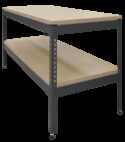Experiment
H11
CENTRE OF PRESSURE
A pivoted clear plastic assembly which students use to find the centre of pressure of a totally or partially submerged plane surface. Compact, self-contained and excellent for classroom demonstrations.
If you have any questions or you'd like to discuss a product, please call us.
+44 1159 722 611CENTRE OF PRESSURE
This product allows students to measure the moment due to the fluid (hydrostatic) thrust on a fully or partially submerged plane. The plane works in either a vertical or inclined (angled) position. Students then compare their measurements with theoretical analysis.
The equipment consists of a vertical panel that holds a clear plastic quadrant, to which students add water. The quadrant has engraved lines to help students keep the plane in a vertical or angled position.
The cylindrical sides of the quadrant have their central axis coincidental with the moment measurement axis. The total fluid pressures on these curved surfaces therefore exert no moment about this pivot. Therefore, the moment is only due to the fluid pressure on the plane test surface. Students measure this moment using weights suspended from a level arm. A scale on the panel of the apparatus shows the head of water.
To perform experiments, students level the apparatus using its levelling feet and spirit (bubble) level. They decide whether to test either a vertical or inclined plane. They then initially balance the quadrant tank using one of the weight hangers and the smaller trimming tank. They take results by balancing incremental weights on the hanger with known quantities of water. They then use the results to calculate the equivalent moment of force (M) or hydrostatic thrust. Students note the relationship between the moment and the water height (h).
The equipment includes non-toxic water dye to help students see the water levels more clearly and a syringe for accurate addition or removal of small amounts of water.
Learning outcomes
- Studying the relationship between hydrostatic force and head of water for a fully and partially submerged vertical and inclined plane
- Comparison of actual and theoretical hydrostatic force on a fully or partially submerged plane for any given head of water
- Theoretical calculation of the position of centre of pressure on a fully or partially submerged plane




